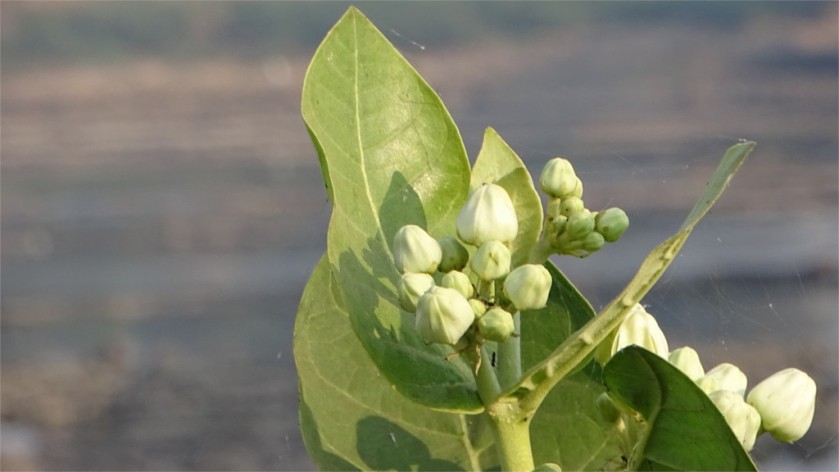You can see milkweed (genus Calotropis), called aak in Hindi, in most parts of India. There are supposed to be three species which grow in India: the giant milkweed or crown flower (Calotropis gigantea) which you see in the featured photo, the milkweed (Calotropis procera) which you see in the photo below, and a species called Calotropis acia which I’m not sure that I have seen. I recognize the giant milkweed flower by its well separated and pointed petals and the fact that it is odourless. The milky sap which oozes from broken stems of aak is poisonous when ingested. That poison is used by several butterfly species, notably the one called Common Tiger (Danaus genutia). Its caterpillar gorges on these leaves, and incorporates the poison into its body. As a result, the caterpillar, and the adult which emerges from it, become poisonous. I’ve also seen ants swarming over milkweed, and wondered whether they use the chemicals in some way.
The flowers of C. procera also have the fivefold symmetry, but the petals are not as long and well-separated as that of the C. gigantea. If the bushes are fully grown, then one can tell the two species apart from the fact that the C. gigantea can grow substantially taller than a man, whereas the C. procera is about the same height as a tall person. I’ve never dug up one of them to examine the roots. Since they grow in arid climates, I would guess that their roots are deep and far-ranging. Very often several bushes grow near each other. I wonder whether their roots are in communication.
The colours of the flowers are variable, although most of the time they are on the spectrum of purples: from blue to red. When I first saw the white or greenish white flowers I wondered whether they are another species. But apparently the colour of flowers is not a species marker amongst milkweed. I cannot quite identify the bush whose photo you see above, because the buds haven’t opened up, but from the size I guess it is more likely to be C. gigantea. There’s been a lot of laboratory work separating the toxins from milkweed and examining their action separately and in combination.
Of all the uses of the milkweed, I guess the most widespread is its use in religion: as an offering to Shiva. The iconography of Shiva sometimes shows him with the white variety bound into his hair, giving a possible etymology to the name crown flower. The photo that you see above was taken near the temple of Omkareshwar on the banks of the Narmada. There was a whole line of such stalls on the walkway leading to the temple. I asked the lady in front of the basket what the spiny pods were, and she told me they were fruits of aak, also used in devotions. The seed pods of C. procera and C. gigantea are not spiny. So I wonder whether I have finally seen something of the elusive C. acia.





